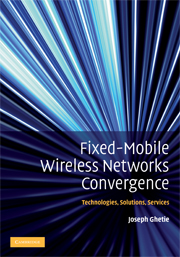Book contents
- Frontmatter
- Contents
- Disclaimer
- How the Book is Organized
- List of Figures
- List of Tables
- Preface
- Acknowledgments
- Acronyms
- Part I Wireless Communications: Networking and Management
- 1 Wireless Communications and Networking
- 2 Network Management
- 3 Service Management
- Part II Cellular Mobile Radio Networking and Management
- Part III Fixed Wireless Technologies: Networking and Management
- Part IV Fixed Wireless Cellular Mobile Networks Convergence and Integration
- Part V Fixed Wireless Cellular Mobile Networks Convergence: Standardized Networking Solutions
- Part VI Fixed-Mobile Convergence Services, Industry Trends, and Implementation Issues
- References
- Index
1 - Wireless Communications and Networking
from Part I - Wireless Communications: Networking and Management
Published online by Cambridge University Press: 21 August 2009
- Frontmatter
- Contents
- Disclaimer
- How the Book is Organized
- List of Figures
- List of Tables
- Preface
- Acknowledgments
- Acronyms
- Part I Wireless Communications: Networking and Management
- 1 Wireless Communications and Networking
- 2 Network Management
- 3 Service Management
- Part II Cellular Mobile Radio Networking and Management
- Part III Fixed Wireless Technologies: Networking and Management
- Part IV Fixed Wireless Cellular Mobile Networks Convergence and Integration
- Part V Fixed Wireless Cellular Mobile Networks Convergence: Standardized Networking Solutions
- Part VI Fixed-Mobile Convergence Services, Industry Trends, and Implementation Issues
- References
- Index
Summary
Communications Networks
Communications by voice and physical signaling are common means of interaction between human beings. In the simplest forms, there is an emitting entity of information and a receiving entity of information. As the sources move apart the need for telecommunications appears self-evident. This simple model of communications becomes more complex when the information transmitted is not just sound, speech, or music, but full motion video images or various forms of data such as text, shared files, facsimile, graphics, still images, computer animation or instrumentation measurements. This information can be transmitted using electrical or optical signals, the native analog information undergoing numerous conversions and switching to accommodate various communications technologies. Telecommunications can take place over various media be that twisted copper pairs, coaxial cable, fiber optic, or wireless radio, microwave, satellite, and infrared links. Communication can be limited to a small group of people or extended to departments, compounds, or campuses and covering whole metropolitan areas, regions, countries, or continents. Hence, a shared infrastructure is needed, i.e., a communications network.
Communications networks can be classified in many ways, as there are distinct technologies and network equipment needed for voice communications, data/computer communications, and video communications. Among these types of communications, data communications, by the virtue of digitization of any type of information, has become the convergent system.
Information
- Type
- Chapter
- Information
- Fixed-Mobile Wireless Networks ConvergenceTechnologies, Solutions, Services, pp. 3 - 24Publisher: Cambridge University PressPrint publication year: 2008
